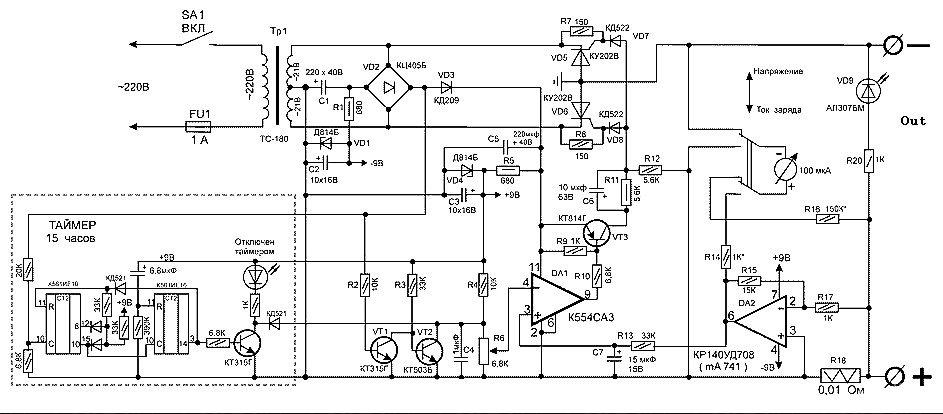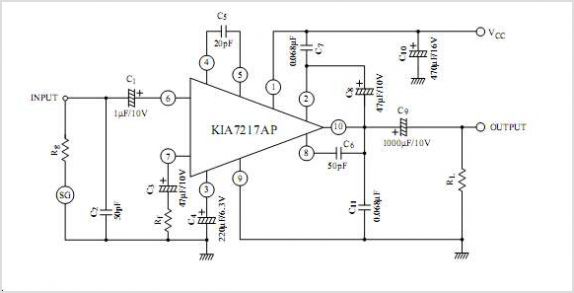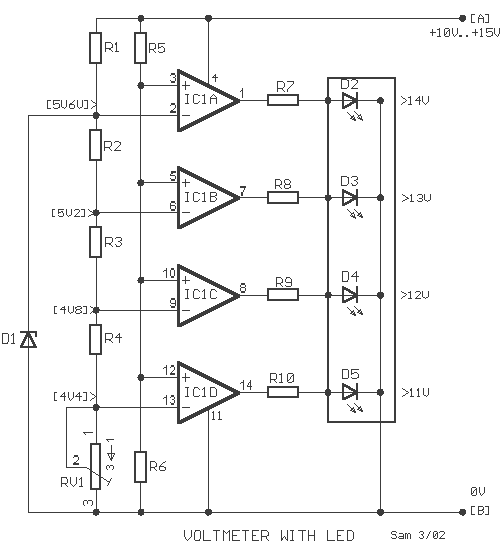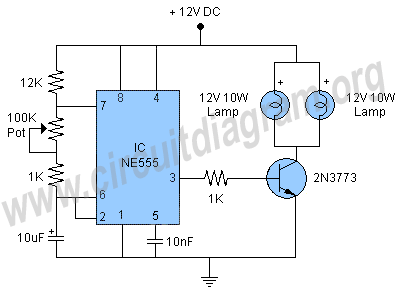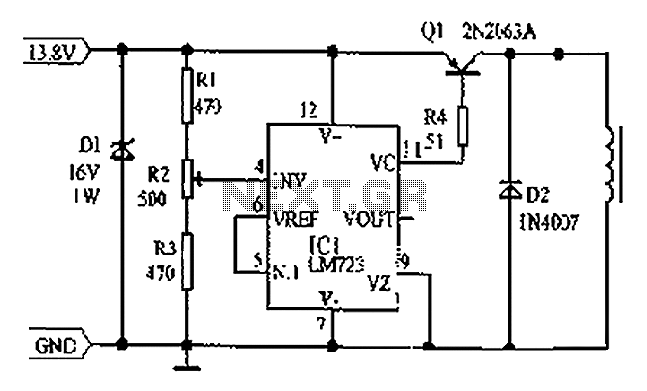
Car Boot Lamp Warning (ICM7556)
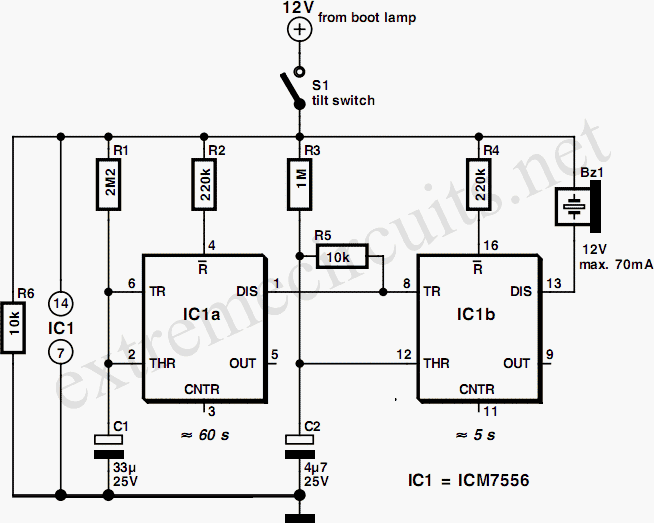
In many vehicles, the boot light remains illuminated until the lid is fully closed. It is common to inadvertently leave the lid slightly open while unloading, which can lead to a drained battery if the car is not used for an extended period. This circuit provides a warning for such situations. A mercury tilt switch is installed in the boot so that its contacts close as the lid approaches full closure. The circuit is powered by the switched 12 V supply to the boot lamp and the mercury switch. When the lid is properly closed, the boot lamp turns off, and the circuit supply drops to zero. Conversely, if the lid is left ajar, the lamp remains on, and the mercury switch completes the circuit. After a delay of 5 seconds, an alarm will activate, which will continue for 1 minute unless the lid is closed, serving as a reminder to secure the boot. This 1-minute duration prevents continuous alarming when transporting larger items that may prevent the lid from closing completely. The circuit utilizes a dual CMOS timer, specifically the 7556, as the bipolar 556 version is unsuitable. Upon activation (when the boot lid is ajar), tantalum capacitors C1 and C2 ensure that the timer outputs remain high. After roughly 5 seconds, when the voltage across C2 reaches 2/3 of the supply voltage, timer IC1b is triggered, causing the alarm to sound. Meanwhile, the voltage across C1 rises more slowly, and after about 1 minute, it reaches 2/3 of the supply voltage, triggering IC1a, which resets IC1b and turns off the alarm. IC1a remains in this state until the boot lid is either closed or opened wider, at which point C1 and C2 discharge through R6, resetting the circuit for future operation. The timer periods can be calculated using the formula: t = 1.1RC. It is important to use tantalum or electrolytic capacitors with a solid electrolyte in this circuit, and the buzzer must be a suitable type for DC operation, including a built-in driver.
The circuit design incorporates several key components to ensure reliable operation. The mercury tilt switch is strategically positioned to detect the angle of the boot lid, providing a quick response to its position. The dual timer arrangement allows for precise control of timing intervals, essential for the alarm function. Tantalum capacitors are chosen for their stability and performance in timing applications, ensuring accurate timing and minimizing drift.
The 12 V supply to the boot lamp serves a dual purpose, powering both the lamp and the alarm circuit. The use of a buzzer with a built-in driver simplifies the design, as it eliminates the need for additional amplification stages. The inclusion of resistors and capacitors in the timing circuit enables fine-tuning of the alarm duration and response time, allowing customization based on user requirements or specific vehicle characteristics.
In terms of assembly, careful attention must be given to the placement of the components to minimize interference and ensure reliable operation. The circuit should be housed in a protective enclosure to prevent damage from environmental factors, such as moisture or vibration, which are common in automotive applications. Proper grounding techniques should be employed to avoid noise issues that could affect the functionality of the timers and the alarm system.
Overall, this circuit provides an effective solution to a common problem faced by vehicle owners, enhancing convenience and preventing battery drain through a simple yet efficient alarm system.On many cars, the boot light will not go out until the lid is properly closed. It is all too easy when unloading the car, to leave the lid ajar. If you are unlucky and the car remains unused for some time, the next time you try to start it, the lamp will have drained the battery and you will no doubt utter a few appropriate words. The circuit desc ribed here will give a warning of just such a situation. A mercury tilt switch is mounted in the boot so that as the lid is closed, its contacts close before the lid is completely shut. The supply for the circuit comes from the switched 12 V to the boot lamp and through the mercury switch.
When the lid is properly closed, the boot lamp will go out and the supply to the circuit will go to zero. If however the lid is left ajar, the lamp will be on and the mercury switch will close the circuit. After 5 seconds, the alarm will start to sound, and unless the lid is shut, it will continue for 1 minute to remind you to close the boot properly.
The 1-minute operating period will ensure that the alarm does not sound continuously if you are, for example, transporting bulky items and the boot will not fully close. The circuit consists of a dual CMOS timer type 7556 (the bipolar 556 version is unsuitable for this application).
When power is applied to the circuit (i. e. the boot lid is ajar) tantalum capacitors C1 and C2 will ensure that the outputs of the timers are high. After approximately 5 seconds, when the voltage across C2 rises to 2/3 of the supply voltage, timer IC1b will be triggered and its output will go low thereby causing the alarm to sound.
Meanwhile the voltage across C1 is rising much more slowly and after approximately 1 minute, it will have reached 2/3 of the supply voltage. IC1a will now trigger and this will reset IC1b. The alarm will be turned off. IC1a will remain in this state until the boot lid is either closed or opened wider at which point C1 and C2 will be discharged through R6 and the circuit will be ready to start again.
To calculate the period of the timers use the formula: t = 1. 1RC Please note that the capacitor type used in the circuit should be tantalum or electrolytic with a solid electrolyte. The buzzer must be a type suitable for use at D. C. (i. e. one with a built in driver). 🔗 External reference
The circuit design incorporates several key components to ensure reliable operation. The mercury tilt switch is strategically positioned to detect the angle of the boot lid, providing a quick response to its position. The dual timer arrangement allows for precise control of timing intervals, essential for the alarm function. Tantalum capacitors are chosen for their stability and performance in timing applications, ensuring accurate timing and minimizing drift.
The 12 V supply to the boot lamp serves a dual purpose, powering both the lamp and the alarm circuit. The use of a buzzer with a built-in driver simplifies the design, as it eliminates the need for additional amplification stages. The inclusion of resistors and capacitors in the timing circuit enables fine-tuning of the alarm duration and response time, allowing customization based on user requirements or specific vehicle characteristics.
In terms of assembly, careful attention must be given to the placement of the components to minimize interference and ensure reliable operation. The circuit should be housed in a protective enclosure to prevent damage from environmental factors, such as moisture or vibration, which are common in automotive applications. Proper grounding techniques should be employed to avoid noise issues that could affect the functionality of the timers and the alarm system.
Overall, this circuit provides an effective solution to a common problem faced by vehicle owners, enhancing convenience and preventing battery drain through a simple yet efficient alarm system.On many cars, the boot light will not go out until the lid is properly closed. It is all too easy when unloading the car, to leave the lid ajar. If you are unlucky and the car remains unused for some time, the next time you try to start it, the lamp will have drained the battery and you will no doubt utter a few appropriate words. The circuit desc ribed here will give a warning of just such a situation. A mercury tilt switch is mounted in the boot so that as the lid is closed, its contacts close before the lid is completely shut. The supply for the circuit comes from the switched 12 V to the boot lamp and through the mercury switch.
When the lid is properly closed, the boot lamp will go out and the supply to the circuit will go to zero. If however the lid is left ajar, the lamp will be on and the mercury switch will close the circuit. After 5 seconds, the alarm will start to sound, and unless the lid is shut, it will continue for 1 minute to remind you to close the boot properly.
The 1-minute operating period will ensure that the alarm does not sound continuously if you are, for example, transporting bulky items and the boot will not fully close. The circuit consists of a dual CMOS timer type 7556 (the bipolar 556 version is unsuitable for this application).
When power is applied to the circuit (i. e. the boot lid is ajar) tantalum capacitors C1 and C2 will ensure that the outputs of the timers are high. After approximately 5 seconds, when the voltage across C2 rises to 2/3 of the supply voltage, timer IC1b will be triggered and its output will go low thereby causing the alarm to sound.
Meanwhile the voltage across C1 is rising much more slowly and after approximately 1 minute, it will have reached 2/3 of the supply voltage. IC1a will now trigger and this will reset IC1b. The alarm will be turned off. IC1a will remain in this state until the boot lid is either closed or opened wider at which point C1 and C2 will be discharged through R6 and the circuit will be ready to start again.
To calculate the period of the timers use the formula: t = 1. 1RC Please note that the capacitor type used in the circuit should be tantalum or electrolytic with a solid electrolyte. The buzzer must be a type suitable for use at D. C. (i. e. one with a built in driver). 🔗 External reference
Warning: include(partials/cookie-banner.php): Failed to open stream: Permission denied in /var/www/html/nextgr/view-circuit.php on line 713
Warning: include(): Failed opening 'partials/cookie-banner.php' for inclusion (include_path='.:/usr/share/php') in /var/www/html/nextgr/view-circuit.php on line 713
